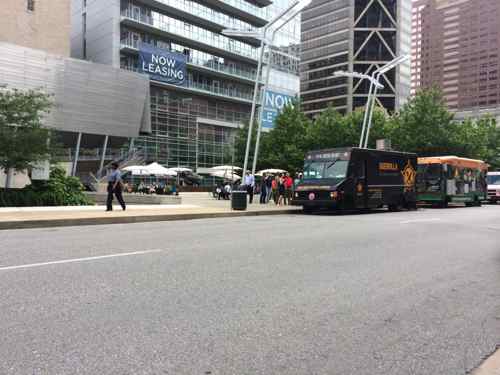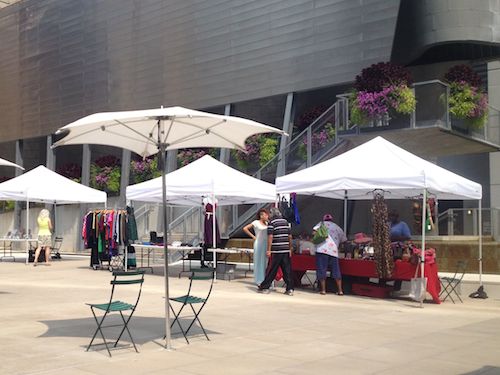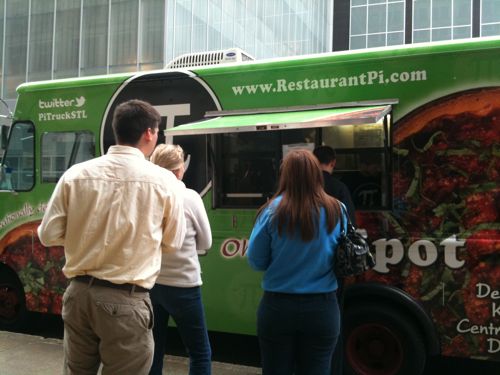The host of this site, Steve Paterson, has long been a proponent for more street vendors, and specifically hot dog carts, in downtown St. Louis. I’ve always been a bit lukewarm to the concept, assuming that supply and demand is probably near equilibrium already, since several permit holders choose to operate now only on an irregular basis.  Still, there are types of street food that I see having some real potential, and that’s with mobile catering trucks, a.k.a. “roach coaches”, that have “evolved” into more interesting forms in other cities.
One format, that could work great at any of our local universities, has become established at Rutgers University, where their “Grease Trucks” have been both embraced by the university, both its students and the administration, and appears to be cranking out some good, affordable food.
On the other coast, gourmet dining has joined with Twitter to create a mobile gastronomic experience:
Portland’s bustling street-food scene may soon be rivaling the hawker centers of Singapore in terms of quality, scope, popular appeal, and value for money. In other words, the Pacific Northwest is doing for street food today what it did for coffee in the 1990s. Picking just eight venues out of the veritable sea of stands, stalls, carts, trucks, trailers, and even bicycles was a tough job-but hey, we’re not complaining. (full article: Gourmet Magazine)
The infamous $16 pho. The $10 kaya toast that everyone loved but that I’m used to getting for less than $1 back home. These were all reasons I haven’t checked out Susan Feniger’s STREET until now. The concept is awesome. Street food from all over the world, all in one spot. In Hollywood. But one kitchen and how many countries? Can they pull it off? (full article: Gourmet Pigs)
Numerous restaurants in Seattle feature gourmet dishes prepared with local and seasonal ingredients. But only one serves its meals through the window of a 1962 Airstream trailer.
Skillet, a roving kitchen that stakes out different street corners during lunch hour, is known for a Kobe-style burger served on brioche with bacon jam, blue cheese and arugula. The locally and seasonally inspired menu continually changes, prompting customers to line up every day and debate between crispy ginger pork wontons accompanied by a sweet chili dipping sauce or Thai cured confit of duck with a coconut rice salad. (full article: Forbes)
Even Denver has Biker Jim and his gourmet dogs.
The advantage that enclosed vehicles offer over open carts is primarily the ability to do more real cooking. The typical hot dog cart keeps dogs warm and drinks cold. Some assembly is required, but little culinary skill. St. Louis also apparently allows our vendors to work off of portable grilles, which partially blurs the lines. But to do real cooking requires running water, refrigeration and more control than just one gas or charcoal grille. Plus, more than a few of us are suspicious of the sanitation any open location can maintain, day in and day out.
The two big challenges that these vehicles face are the impact on the urban environment (do we want one or more parked on Washington every weekend night?) and the reality that they “steal” business from existing brick-and-mortar restaurants with higher overhead. Plus, like what happened at Rutgers, there’s a tendency for them to become non-mobile when they find a successful location. Denver requires that they actually move on a daily basis, as apparently does LA, but with the ability to reach out via Twitter, it’s become a lot easier to find one’s favorite.
Personally, I think they’d be a great addition to St. Louis’ street and dining scenes – I’d like to hear what others think . . .
– Jim Zavist







